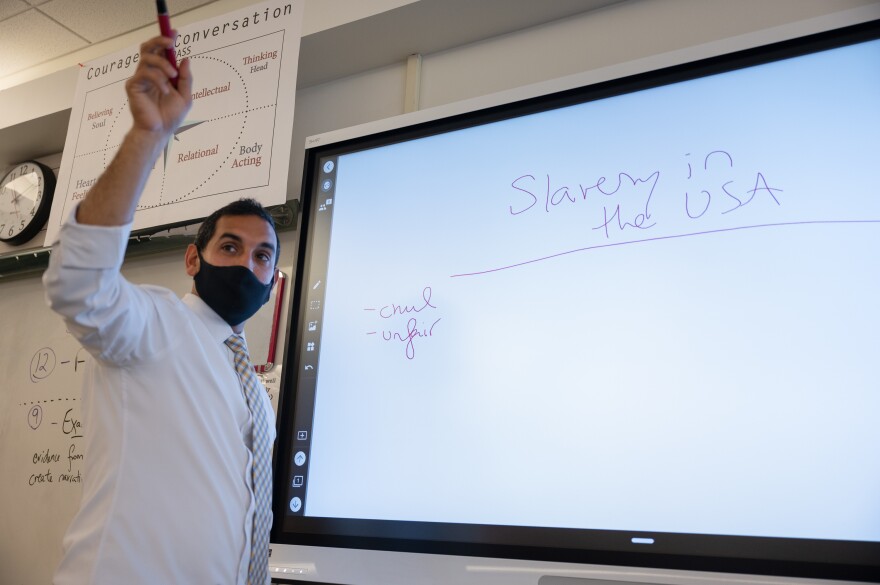Brandon Rodriguez is getting ready for his fourth-period Black and Latino history class. Rodriguez, a high school senior, says he signed up for the course to learn more about his ancestry.
“My parents were born in Ecuador, but I was born here,” Rodriguez said. “But it’s nice to learn a little bit more about your Hispanic side and the impacts or benefits they’ve done in this country.”
Connecticut passed Public Act 19-12 in 2019, which requires all high schools in the state to offer courses on African, Black, Puerto Rican and Latino studies beginning in 2022. Danbury’s Abbott Technical is among 50 public high schools piloting the elective course. The law signed by Gov. Ned Lamont requires all high schools to offer a course that covers African American studies in the first semester and Latino history in the second. But it does not require that every student take it.
The curriculum written by the State Education Resource Center, or SERC, was completed over the summer. It’s the same curriculum that Adrian Solis is teaching to Rodriguez’s senior class.
Inside his classroom, the discussion begins with a prompt.
“I’m going to put a phrase up on the board. Your job is to come up with one word,” said Solis as he wrote “Slavery in the U.S.” on the board. As offered by the curriculum, the course begins with an introduction to African origins and contributions of ancient African empires and the African diaspora. It moves through topics of slavery and freedom to Black liberation movements in the U.S.
Solis says that growing up as a Latino in a suburban town, he didn’t learn about his own history until college.
“I’m so glad I’m able to at least play a little role in it to help these kids learn about themselves a little bit,” said Solis, who teaches social studies.
Deciding what to include in the 90-day lesson plans of Latino studies involved discussion and reflection among a racially diverse committee, said Nitza Diaz, an education consultant with SERC. It included teachers, administrators, state employees and community members.

“So we start with who we are, in the context of indigenous and the colonizers, Spaniards and enslavement,” said Diaz. “And then who we are in the United States.”
The course then dives into a unit called Blood and Beauty. It explores Christopher Columbus’ arrival in the Americas with students also reading about Bartolome de las Casas’ writings on Spaniards’ treatment of indigenous populations.
Diaz explains that the course moves through themes, rather than a chronology. But she says the material can also cause students distress or shock. Diaz recalls one pilot class where students participated in a lesson about police brutality against Latinos.
“There was a student there, and she stayed quiet, and everybody’s quiet,” Diaz said. “And somebody else said, ‘This was so hard to watch. I cannot believe they did that to us.’ “But then somebody said, ‘It was hard, but it was the truth.’”
When speaking to teachers and facilitators, Diaz emphasizes attention to creating a safe space for students to discuss and process, particularly in diverse classrooms.
Solis also played a role in designing the Latino portion of the course. The final units dive into Latino civil rights movements, like the case of Mendez v. Westminster that banned the forced segregation of Mexican Americans and was a precursor to Brown v. Board of Education. They also look at the intersections of Latinos and African Americans. In between, they’ll study the United States’ relation to Puerto Rico and present-day politics. But Solis says it all ties back to hyper-local history.
“It’s kind of like closure as to where are Latinos now, specifically in Connecticut. This whole course is focused on Connecticut’s history,” Solis said.
During class, Brandon Rodriguez learned about the involvement of Connecticut in slavery in the cotton and sugar trade and the nearly 5,000 enslaved people in the state.

“Today’s class was the most surprising,” said Rodriguez. “Learning about how Connecticut used slaves to profit off of them and how it became a way to make them enough money for them be [considered] one of the richest states back then.”
With that window into a different history briefly opened, Rodriguez heads to his fifth-period statistics class.
Copyright 2021 Connecticut Public Radio




